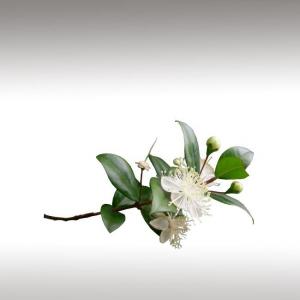
MYRTLE ESSENTIAL OIL (MYRTUS COMMUNIS) - ESSENTIAL OILS

BASE / GENERAL DATA
Information submited: March 26, 2015 Modified: March 15, 2018 By: OperaDreamhouse
Botanical Name: Myrtus communis
Common Method of Extraction: Steam distilled
Part Typically Used: Leaves and twigs
Color: Pale yellow to orange
Consistency: Light/Thin
Perfumery Note: Top/middle
Strength of Initial Aroma: Fresh, sweet, camphoraceous
Myrtus Communis is also referred to as Common Myrtle or True Myrtle. Derived from Latin, the word means "Chaste Beauty".
Myrtus Communis, is a native shrub in the Middle East. It grows in all the countries that border the Mediterranean. Countries where Myrtle is native include: Turkey, Morocco, Algeria, Tunisia, France, Spain, Greece, and Italy. It has been brought to southern Britain and southern France.
The plant is an evergreen shrub or small tree, growing to 5 metres tall. The leaf is entire, 3 - 5 cm long, with a fragrant essential oil.
Myrtle essential oil comes from a small tree with many tough slender boughs. It has a brownish red bark with small pointed leaves. It produces flowers which turn into black berries: both the flowers and leaves are very fragrant.
The oil can be extracted from the leaves, branches, and berries. The oil that is most commonly used medicinally is extracted from the leaves. This oil will be liquid at room temperature. The color will range from clear to greenish - yellow to yellow - very - light - orange. Its aroma is reminiscent of Frankincense or bay. Some examples of Myrtle oil have a slight hint of Camphor or Eucalyptus. The oil from the Myrtle berries is used as a flavoring for drinks and alcoholic beverages throughout the Mediterranean Area.
The Myrtle plant first appears in history in ancient Greece, and it was associated with Aphrodite, the Goddess of Love and Beauty. Furthermore, the bravest soldiers, athletes and nobles were honored with its leaves.
At the Veneralia, women bathed wearing crowns woven of Myrtle branches, and Myrtle was used in wedding rituals. In the Aeneid, Myrtle marks the grave of the murdered Polydorus in Thrace.
Neo-pagan and wicca rituals, Myrtle, though not indigenous beyond the Mediterranean Basin, is now commonly associated with and sacred to Beltane (May Day).
Common Method of Extraction: Steam distilled
Part Typically Used: Leaves and twigs
Color: Pale yellow to orange
Consistency: Light/Thin
Perfumery Note: Top/middle
Strength of Initial Aroma: Fresh, sweet, camphoraceous
Myrtus Communis is also referred to as Common Myrtle or True Myrtle. Derived from Latin, the word means "Chaste Beauty".
Myrtus Communis, is a native shrub in the Middle East. It grows in all the countries that border the Mediterranean. Countries where Myrtle is native include: Turkey, Morocco, Algeria, Tunisia, France, Spain, Greece, and Italy. It has been brought to southern Britain and southern France.
The plant is an evergreen shrub or small tree, growing to 5 metres tall. The leaf is entire, 3 - 5 cm long, with a fragrant essential oil.
Myrtle essential oil comes from a small tree with many tough slender boughs. It has a brownish red bark with small pointed leaves. It produces flowers which turn into black berries: both the flowers and leaves are very fragrant.
The oil can be extracted from the leaves, branches, and berries. The oil that is most commonly used medicinally is extracted from the leaves. This oil will be liquid at room temperature. The color will range from clear to greenish - yellow to yellow - very - light - orange. Its aroma is reminiscent of Frankincense or bay. Some examples of Myrtle oil have a slight hint of Camphor or Eucalyptus. The oil from the Myrtle berries is used as a flavoring for drinks and alcoholic beverages throughout the Mediterranean Area.
The Myrtle plant first appears in history in ancient Greece, and it was associated with Aphrodite, the Goddess of Love and Beauty. Furthermore, the bravest soldiers, athletes and nobles were honored with its leaves.
At the Veneralia, women bathed wearing crowns woven of Myrtle branches, and Myrtle was used in wedding rituals. In the Aeneid, Myrtle marks the grave of the murdered Polydorus in Thrace.
Neo-pagan and wicca rituals, Myrtle, though not indigenous beyond the Mediterranean Basin, is now commonly associated with and sacred to Beltane (May Day).

SPIRITUAL PRACTISES DATA

MEDICINE / HEALTH DATA

BEAUTY / COSMETICS DATA

FOOD / COOKING DATA
COMMENTS
No comments.


